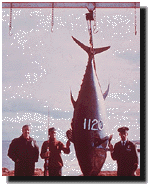
Enjoying a very diverse fishery, Prince Edward Island
markets its fish harvest to countries around the world.
This fishery is divided into two sets of categories, the
first set distinguishes between the inshore and offshore
fisheries while the second set differentiates between
pelagic/estuarial fish and groundfish. The inshore
fishery takes place around the Island’s perimeter.
Fishers take daily trips in vessels under 50 feet in
length, weighing less than ten tonnes. The offshore
fishery involves overnight trips. Vessels are larger:
over fifty feet in length and weighing more than ten
imperial tons. Prince Edward Island’s fishery is
mainly inshore, with individual fishermen owning their
own boats. The offshore fishery employs fewer people in
the province. It involves larger operations owned by
companies that are more capital-than labour-intensive.
These vessels, however, harvest large volumes of fish.
The relatively small number of offshore fleets is more
than offset by the volume of their catch.

Groundfish and Pelagic Fish differ according to type of
habitat. Groundfish live close to the land and on banks
further from the land. The most commercially viable
fishery in groundfish has historically included cod,
dogfish, flounder, hake, and redfish. These are fished
using Danish seines, handlines, jiggers, longlines, and
gill nets and tangle nets respectively. Pelagic and
estuarial fish live in the open sea or in tidal rivers.
They include eels, gaspereau, herring, mackerel,
silversides, smelts, and bluefin tuna.
The past few years have been marked by increased
awareness and concern over groundfish stocks in Atlantic
Canada. In mid–1993, the groundfishery was closed
and it was decided that the industry would not re-open
until stocks were replenished and the federal Department
of Fisheries and Oceans was confident that harvest levels
would be sustainable. The purpose of the moratorium and
accompanying licence buy-outs and the famous Atlantic
Groundfish Strategy (TAGS) has been to reduce dependence
on the fishery so that pressures on fish stocks would be
reduced. Thankfully, many Islanders engaged in the
groundfishery also participate in other fisheries (such
as lobster, shellfish or herring) and are not being
negatively affected on as wide a scale as some of our
Atlantic Canadian neighbours.
Atlantic cod is the region’s most famous groundfish.
Most of the commercial-sized cod found in the
southwestern Gulf of St. Lawrence during the summer
months migrate into deeper water southeastward out of the
Gulf in late fall. Cod is caught by otter trawls, line
trawls, jiggers, gill nets, and other methods. The fish
is sold fresh, frozen, smoked, salted or canned and
by-products are used in commodities such as fish meal and
cod liver oil.
During the winter’s coldest months, many frozen
bays and estuaries across the Island are dotted with a
smattering of small huts made of plywood, or tarpaulin
wrapped around a frame or even fibreglass and vinyl.
These “smelt shacks” are erected over small
holes drilled into the ice to fish smelts, which are
caught using gill nets or box nets between early October
and February 28.
Eels are abundant in Island waterways and can be fished
virtually any time of year. The commercial fishery for
eels takes place from April 1 until June 30 and from
August 16 until October 31. The recreational fishery for
eels is in effect from December 1 until March 31. Island
silversides fishers market their harvest to markets in
the United States where the fish is sold as bait. Marine
parks use silversides as food for dolphins.
